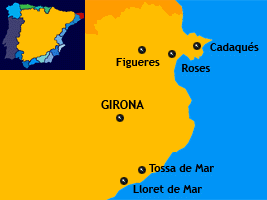 |
Spain | Travel | Regions | Cities | Coasts | Islands | Culture |
| Spain / Catalonia / Costa Brava |
|
| More Information | ||
| Destinations | ||
| Plan your Trip | ||
| ||||||
 The Costa Brava is the northeastern part of the Spanish Mediterranean coast which belongs to the province of Girona. It extends over a length of 214 kilometers from the French border to the Costa del Maresme, which already belongs to Barcelona.
The Costa Brava is the northeastern part of the Spanish Mediterranean coast which belongs to the province of Girona. It extends over a length of 214 kilometers from the French border to the Costa del Maresme, which already belongs to Barcelona.The name "Costa Brava" (Wild Coast) probably derives from the rocky parts of the coastline. There are however also beautiful bays, in which the best known holiday resorts are located. By the middle of the 20th century, these places were just small fishing villages. The scenic beauty of the region attracted many artists such as Marc Chagall, Picasso, Rusiñol und Salvador Dali. During the 1950ies more and more tourists came to visit the coast, and from about 1960 the villages which had sandy beaches began to develop into tourist centers. So today places like Tossa de Mar or Lloret de Mar dispose of numerous hotels and leisure facilities, while the villages along the rocky parts of the Costa Brava remained almost untouched by tourism. One of these picturesque coast towns, which can be reached only by a winding mountain road, is Cadaqués The Theater-Museum Dali in Figueres The Castle Gala-Dali in Púbol Along the Costa Brava there are also several archeological places, which show that the coast was inhabited already before the arrival of Greeks and Romans. In the old-iberian settlement Ullastret The ruins of another iberian settlement, Puig de Castellet The historic town Ampuries |